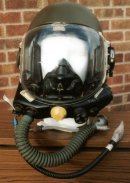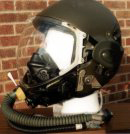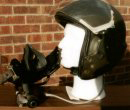|
Correcting
“Jet Age Flight Helmets” and the helmet
description of the United Kingdom Mk.V on page 197, the
correct name for the helmet described is the Mk.5 High
Speed Anti-Blast helmet manufactured by M L Aviation
Company Limited of Maidenhead, Berkshire and not by
Helmets Limited. It was never used by Vulcan crews but was
used for Tornado development trials. Also I might add that
the British helmet numbering system has never used the
Roman numeral system. The M L HSAB (High Speed Anti Blast)
Mk.5 was developed during the late 1960’s and was first
introduced around 1971. The following was taken from the
Provisional Issue of the “Descriptive, Instruction and
Servicing Manual” dated July 1971.
Introduction
The M L Aircrew Protective Helmet Assembly is of the
enclosed helmet type, having a fully integrated mask
oxygen system, as opposed to the conventional open helmet
with separate oxygen mask. It is designed to form a
component of an Aircrew Equipment Assembly compatible with
the flight envelope of modern high-performance aircraft.
In addition to affording air-blast protection at high
ejection speeds, by means of an automatically closing
visor, the helmet assembly also provides a high degree of
impact protection and survival at high altitude – in
both the routine and emergency case. The helmet assembly
is of low weight construction to improve comfort and
reduce wearer fatigue. An anti-glare visor is fitted, and
a communication system, coupled with efficient sound
attenuation, provides signal/noise ratio.
Description
The helmet assembly consists of a main shell of
double-skinned sandwich reinforced plastic construction,
with integrally bonded taped cradle harnesses for the
crown, back and sides of the head. A frontal chin-cup –
hinged on the right and latched on the left – carries
the oxygen mask and suspension, breathing valves and
ductings, and provides support for the lower edge of the
blast visor. All facilities and personal service systems
are contained within or on this structure.
The
side-pivot mounted visor – dyed to dark and light tint
density over upper and lower areas respectively – can be
raised and lowered, or set to any intermediate position,
and also locked into the aperture seal formed by the main
shell and chin-cup. The left side pivot incorporates a
gas-operated mechanism linked to the visor and actuated by
cartridge initiator for automatic operation. At the
commencement of the ejection sequence the initiator is
fired electrically, by means of a seat/aircraft mounted
accumulator pack or pulse generator – the current
passing through the helmet intercom loom – to close and
lock the visor.
The
oxygen mask, having a single point adjustable front
suspension for the exo-skeleton, is mounted at the centre
of the chin-cup. Breathing oxygen, or air/oxygen mixture,
is drawn into the mask cavity from the supply hose and
inspiratory valve, located at the right side of the
chin-cup, via a short length of ducting and a T-piece
mounted at the front of the mask. Exhaled air passes back
through the T-piece and another similar
ducting and exits to atmosphere through an
expiratory valve – compensated to inlet pressure –
located at the left side of the chin-cup. Depending upon
the type of oxygen regulator in use, an anti-suffocation
valve can be fitted into the wall of the mask and a sound
attenuating supply hose fitted in place of the standard
hose.
The
communication system comprises: two hard-wall plastic ear
pads containing telephone receivers, a microphone fitted
in the wall of the mask, a microphone switch mounted at
left centre in the chin-cup and a supply cable,
terminating in a jack-in type plug, depending from the
lower right hand edge of the main shell.
The ear pads are faced with replaceable foam filled
– or alternatively, liquid filled – circumaural seals,
and suspended by side cradle harnesses incorporating a
tensioning toggle mechanism.
Soft
leatherfaced pads, located at the brow and back of the
head, in conjunction with chin-strap incorporating a
quick-release buckle, the ear pads and the supporting
cradle harnesses, provide location and stability for the
helmet assembly.A two-piece lined fabric neck skirt,
overlapping and joined at the hinge/latch interface, is
attached to the lower edge of the main shell and chin-cup
for additional air-blast protection and comfort.
The
two examples in my collection consist of a Prototype Mk.5
and a conventional Mk.5/6. There is a variation which was
for use where operational conditions relating to ejection
air-blast requirements were not so stringent and the high
speed capability was not warranted. This helmet consisted
of the conventional open type retaining many features of
the basic type HSAB, including an automatically closing
visor, but was fitted with attachments for the type
MBU-5/P (or similar) oxygen mask assembly for general
purpose application. It was maybe this latter type that
was used in the Vulcan aircraft although I do not know of
any recorded instances
of its use. |

prototype of the HSAB

Leftside view of the HSAB

visor and facepiece open

Closeup of the mask

Closeup of the facepiece

The conventional HSAB

Leftside view
|